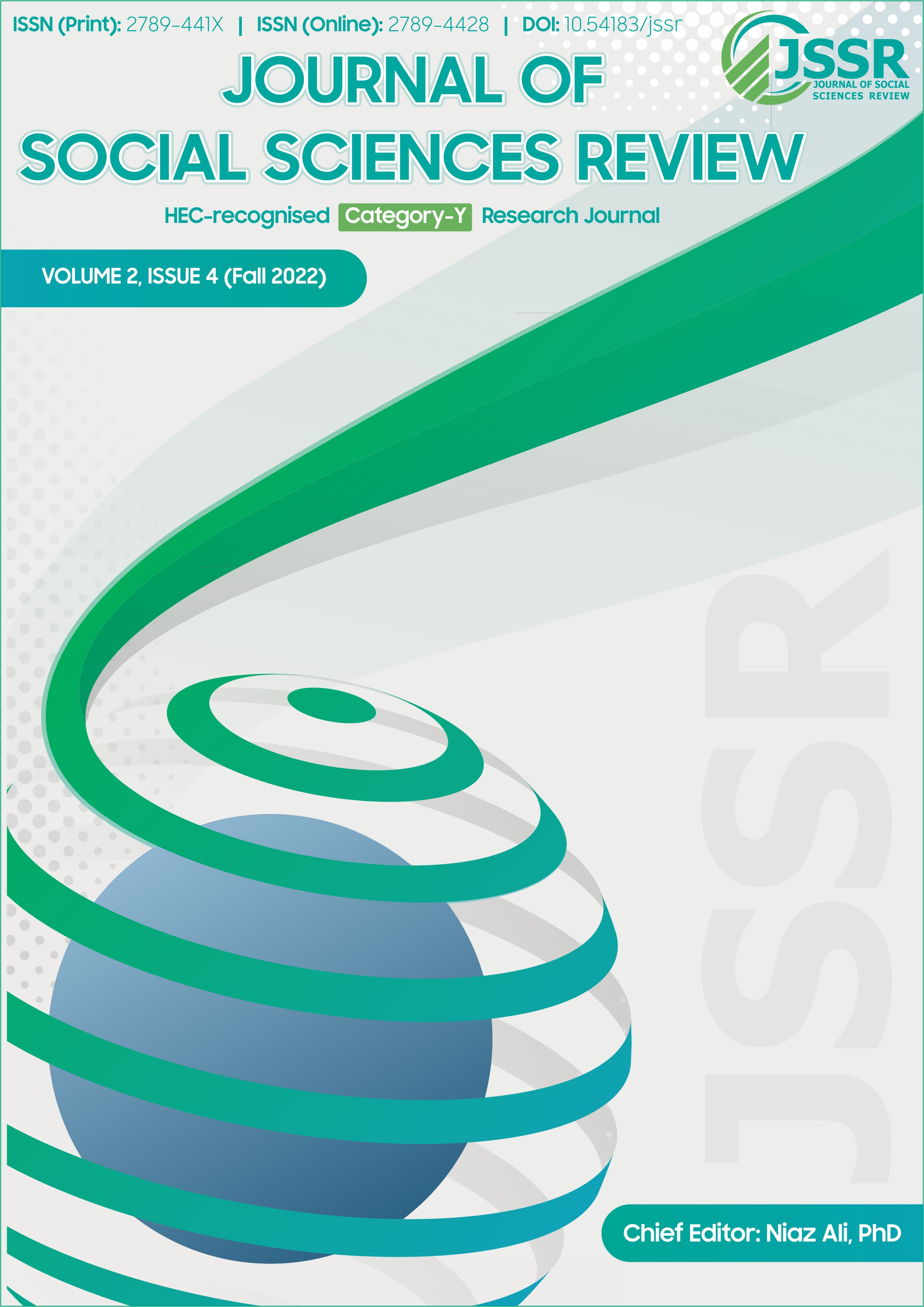Relationship of Personality Traits Hexaco and Self Esteem in University Students
DOI:
https://doi.org/10.54183/jssr.v2i4.69Keywords:
Agreeableness, Extraversion, Gomal University, Honesty-humility, Self-esteemAbstract
Self-esteem reveals the individual’s sense of worth and the degree to which the individual values himself. It represents the individual’s general as well as personal feelings diagonally the time and context. It pertains to the personnel evaluation regarding their potential, worth, capabilities and norms. Therefore, this research was carried out to analyze the HEXACO (conscientiousness, openness, honesty-humility, extraversion, neuroticism and agreeableness) in association with the self-esteem of university students. For this purpose, 300 participants of different ages, gender, education level and residence were included in the study. The data was collected on a predesigned questionnaire and was analyzed using statistical tools. It was found that openness, conscientiousness, and self-esteem, were substantially higher (p<0.05) in males, but extraversion, agreeableness, and neuroticism were significantly higher in females (p<0.05). Honesty-humility was also higher in female students. Further evaluations revealed that openness, conscientiousness, extraversion, agreeableness, and honesty-humility were significant positive predictors (p<0.05) of self-esteem in university students, whereas neuroticism served as a significant (p<0.05) negative interpreter of self-esteem. Hence, it was concluded from this research that personality traits affect all elements of university students and are strongly associated with their self-esteem.
References
Amirazodi, F. & Amirazodi, M. (2011). Personality traits and Self-esteem. Procedia - Social and Behavioral Sciences, 29: 713 – 716. https://doi.org/10.1016/j.sbspro.2011.11.296
Ashton, M.C. & Lee, K. (2007). The HEXACO Honesty-Humility, Agreeableness, and Emotionality Factors: A Review of Research and Theory. Personality and Social Psychology Review, 18(2), 139-152. https://doi.org/10.1177/1088868314523838
Bornstein, R.F. (2006). "A Freudian construct lost and reclaimed: The psychodynamics of personality pathology". Psychoanalytic Psychology, 23 (2): 339–353. https://doi.org/10.1037/0736-9735.23.2.339
Caspi, A., Roberts, B.W. & Shiner, R.L. (2005). Personality development: Stability and change. Annual Review of Psychology, 56: 453–84. https://doi.org/10.1146/annurev.psych.55.090902.141913
Ciarrochi, J., Heaven, P.C.L. & Fiona, D. (2007). The impact of hope, self-esteem, and attributional style on adolescents’ school grades and emotional well-being: A longitudinal study. Journal of Research in Personality. 41(6): 1161-1178. https://doi.org/10.1016/j.jrp.2007.02.001
Digman, J.M. (1990). Personality Structure: Emergence of the Five-Factor Model. Annual Review of Psychology, 41(1), 417- 440. https://doi.org/10.1146/annurev.ps.41.020190.002221
Esmaeilpour, K., Kheirodin, J.B. & Sarindizaj, Z.E. (2013). The relationship between HEXACO personality dimensions and type D personality. Journal of Research & Health, 3(3): 405-411.
Jia, R., Bahoo, R., Cai, Z. & Jahan, M. (2022) The Hexaco Personality Traits of Higher Achievers at the University Level. Frontiers in Psychology, 13. https://doi.org/10.3389/fpsyg.2022.881491
Liu, J., Zettler, I., Hilbig, B.E. (2020). Encyclopedia of Personality and Individual Differences. Springer, Cham, pp 1996-2004. https://doi.org/10.1007/978-3-319-24612-3_1228
Mugo, S.M., Mutweleli, S., Ireri, A. & Mwangi, C. (2022). Personality traits as predictors of academic achievement of students in public secondary schools in Murang’a County, Kenya. International Journal of Social Science and Humanities Research, 10(3): 285-295. https://doi.org/10.5281/zenodo.6997426
Niazi, S. (2022). Personality Traits as Predictor of Self-esteem of University Students: Moderating Role of Openness to Experience. Journal of Behavioral Sciences, 27(2): 17.
Rosenberg, M. (1965). Society and the adolescent self-image. Princeton, NJ: Princeton University Press.
Shian, V.C.M., Ayob, N.B., Luva, R.H., Tehseen, S., Meng, C.S., Haider, S.A., & Yusof, M. (2022). Impact of personal characteristics on intrapreneurs’ behaviours. International Journal of Entrepreneurship, 26(4): 1-15.
Skorek, M., Song, A.V. & Dunham, Y. (2014). Self-Esteem as a Mediator between Personality Traits and Body Esteem: Path Analyses across Gender and Race/Ethnicity. PLoS ONE 9(11): e112086. https://doi.org/10.1371/journal.pone.0112086
Thrusfield, M. 2007. Modelling. In Veterinary Epidemiology, 3rd Ed. Blackwell Science Ltd, Oxford, 340-356.
Upadhayaya, S. & Joshi, N.P. (2021). Relationship Between Personality Traits and Academic Achievement of School Students. United International Journal for Research & Technology, 2(9): 41-52.
Varanarasamma, E., Kaur, A., Singh, G. & Muthu, N. (2018). The Relationship between Personality and Self-Esteem towards University Students in Malaysia. Advances in Social Science, Education and Humanities Research, 304(4): 410-414. https://doi.org/10.2991/acpch-18.2019.97
Zeigler, H.V, Holden, C.J., Enjaian, B., Southard, A.C., Besser, A., Li, H. (2015). Self-Esteem Instability and Personality. Personality and Social Psychology Bulletin, 183-198. https://doi.org/10.1177/0146167214559719
Downloads
Published
Issue
Section
License
Copyright (c) 2023 Copyright in the Journal of Social Sciences Review is retained by the author(s). Authors also grant any third party the right to use the article freely as long as its integrity is maintained and its original authors, citation details and publisher are identified.

This work is licensed under a Creative Commons Attribution-NonCommercial 4.0 International License.
SSR's Editorial Board shares the vision of providing free access to information, education, and science for everyone, thus promoting its content through an OPEN ACCESS POLICY, fulfilling the DOAJ definition of open access. The JSSR adheres to an Open Access and Copyright Licensing Policy based on the belief that making research freely accessible to the public promotes greater global knowledge sharing.
The JSSR uses the Creative Commons Attribution-NonCommercial 4.0 International License. The authors who apply and publish in JSSR consent to abide by the copyright policy set out in the Creative Commons 4.0 license (Attribution-NonCommercial 4.0 International license).
- Copyright in the Journal of Social Sciences Review is retained by the author(s).
- Authors also grant any third party the right to use the article freely as long as its integrity is maintained and its original authors, citation details and publisher are identified.
While "By 'open access' to this literature, we mean its free availability on the public internet, permitting any users to read, download, copy, distribute, print, search, or link to the full texts of these articles, crawl them for indexing, pass them as data to software, or use them for any other lawful purpose, without financial, legal, or technical barriers other than those inseparable from gaining access to the internet itself."



